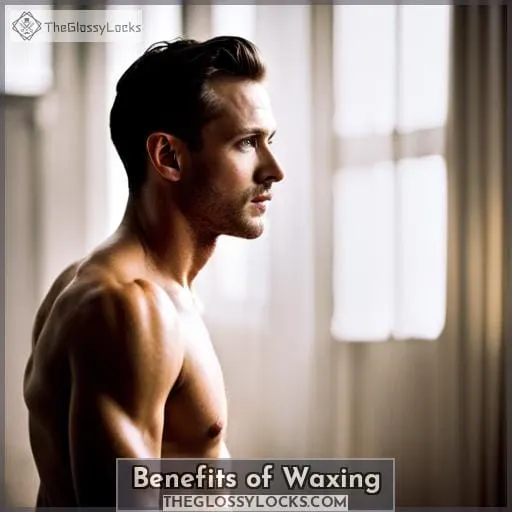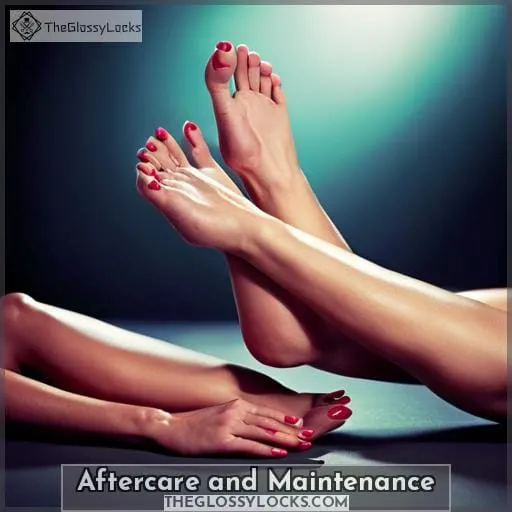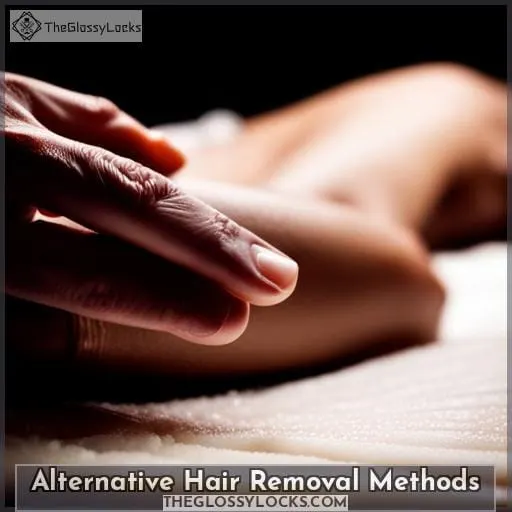This site is supported by our readers. We may earn a commission, at no cost to you, if you purchase through links.
 Dying to book that wax? You’re not alone. The urge for smooth skin is real and can be hard to resist, especially when the dreaded stubble makes its unwelcome appearance.
Dying to book that wax? You’re not alone. The urge for smooth skin is real and can be hard to resist, especially when the dreaded stubble makes its unwelcome appearance.
Turns out it has a lot to do with grip; wax works better if your locks are at least ¼ inch in length – about as big as a grain of rice! So before booking that appointment, read on and learn more here about proper hair lengths for successful waxing treatments along with other helpful tips from experts!
Table Of Contents
Key Takeaways
- Optimal hair length for waxing is at least 1/4 inch or the size of a rice grain.
- Longer hair should be trimmed to prevent breakage, especially in thicker areas.
- Proper grip and technique are crucial for effective waxing, regardless of hair length.
- Regular waxing leads to long-term hair thinning and reduced coarseness.
Recommended Hair Length for Waxing
Having the correct hair length is imperative for successful waxing. Measuring it to be at least a quarter of an inch long and managing regrowth between sessions are key steps in achieving optimal results.
Understanding this importance ensures that waxing can be done comfortably and effectively.
Importance of Proper Hair Length
Ensuring your hair is the right length for waxing is key to achieving a successful and comfortable experience. For optimal grip, effective adhesion, and consistent results, aim for 1/4 inch of growth (the size of a rice grain) – slightly longer in thicker areas.
Preventing discomfort also means avoiding breakage by lightly trimming if hair has grown over 1/2 inch before your bikini line wax or other waxing appointment. To ensure all hairs are removed in the same cycle, measure carefully; gently pulling up on it should be enough to grasp without pinching the skin if at least ¼” long.
How to Measure Hair Length
Gently pull your hair up to get an accurate read on its length—if it can’t be grasped without pinching the skin, it’s too short. To achieve optimal waxing results, measure hair at least 1/4 inch (size of a rice grain).
Thicker areas may require slightly longer than 1/4 inch to prevent breakage during removal. Hair shorter than this won’t adhere properly and could cause discomfort or incomplete removal.
For first-time waxers, aim for around 2 weeks of growth considering individual rates; consistent sessions lead to slower regrowth over time, so trimming might be necessary if the length becomes excessive before each appointment.
Managing Hair Length
Trim any hair that’s longer than 1/2 inch before waxing to ensure the best results. Use gentle trimming techniques and take note of your regrowth timeframes. Consider body area when determining length.
Thicker hairs may need slightly more growth for successful waxing. Don’t let myths about long vs short hairs sway you; both can be effectively removed with proper adhesion and technique! Wax frequently to promote synchronized growth, but spread sessions out 5-6 weeks apart so it’s long enough for effective removal each time.
Benefits of Waxing
Waxing is an effective way to achieve synchronized hair growth, reduce coarseness, and promote long-term thinning. With the right technique, you can enjoy a smoother waxing experience that leaves your skin feeling soft and hydrated.
By understanding the benefits of waxing and following proper guidelines for the length of hair before each session, you’ll be able to ensure success with every application.
Synchronized Hair Growth
Experience the beauty of synchronized hair growth with waxing for a smoother, softer, and more luxurious feel. Waxing helps promote uniformity in your hair regrowth cycle by timing its removal at the optimal length.
Doing so ensures that all hairs are removed in their same growth cycle, leading to coordinated regrowth.
To achieve this effect, make sure your hair is 1/4 inch or slightly longer before waxing. Waxing hair that is shorter may cause breakage due to lack of adhesion. Maintain a regular schedule every 4-6 weeks for waxing.
In between appointments, take care of follicle health by using exfoliation and moisturization products specifically designed for ingrown hairs.
Achieve beautiful locks through consistent waxing!
Reduction in Hair Coarseness
Consistent waxing helps reduce hair coarseness, leaving you with softer and smoother strands – like a baby’s bottom! This Hair Softening Technique not only maintains the texture of your hair but also keeps it looking well-conditioned.
With regular waxing sessions, coarse hairs become finer over time. Waxing is especially beneficial in bikini areas where regrowth can be more rapid and difficult to manage without frequent treatments.
To get maximum results from this Coarse Hair Management approach, stick to a strict waxing timetable that ensures all hairs are removed at the same growth cycle; otherwise, they may break off during removal instead of coming out by the root.
Smooth Skin Secrets have never been easier or more accessible than now – simply follow these Texture Improvement Methods for long-lasting results!
Long-Term Hair Thinning
Achieving a waxing regimen of about 3 times, with sessions spaced 5-6 weeks apart, can result in long-term thinning and softening of the hair. This includes stimulating regrowth for longer-lasting results compared to other hair removal techniques.
Managing coarse hair becomes easier through regular waxing. It also helps maintain results such as reduced coarseness or thinning over months or years.
Waxing has both advantages and disadvantages. However, when done correctly, it is an effective way to achieve smooth skin while managing lengthier regrowth cycles than shaving or epilation.
Types of wax available depend on individual needs. But overall, they ensure successful removal from the root with correct adherence due to proper follicle opening prior to application by a professional technician.
Aftercare and Maintenance
It’s important to practice proper aftercare and maintenance for successful waxing. Exfoliation and moisturization can help keep the skin healthy, while using ingrown hair oils can reduce the risk of developing ingrown hairs.
Additionally, it is recommended to avoid waxing during menstruation due to increased skin sensitivity.
Exfoliation and Moisturization
To keep skin healthy and hair removal smooth, it’s important to exfoliate regularly and moisturize with non-pore clogging products. Pre-waxing preparation is key for successful results. Exfoliating before waxing removes dead skin cells that may prevent the wax from adhering to the hairs properly.
Post-waxing care should include regular exfoliation as well. This helps reduce ingrown hairs and promotes smoother new growth over time. Moisturizing after each session is also crucial. It helps replenish lost hydration, soothe irritation, and provide a protective barrier against bacteria or infection.
This is especially important when using oil-free products specifically designed for post-wax use.
Different types of waxing treatments require varying lengths of pre/post appointment care. However, overall success can be achieved by following these general guidelines for achieving optimal health benefits in between sessions.
Ingrown Hair Prevention
Help keep your skin looking smooth and healthy after waxing by using ingrown hair oils and non-pore clogging moisturizers.
Preventing ingrown hairs requires effective treatment. First, exfoliate regularly with an appropriate scrub. This will help remove dead cells from the surface of your skin without causing damage to the delicate hair follicle.
Next, avoid razor bumps by using a sharp blade when shaving or waxing. A dull blade can cause irritation and increase the risk of ingrown hairs.
Finally, apply specially formulated products to the area. These products are designed to prevent razor burn and irritation. Using them consistently throughout Brazilian wax treatments can help reduce inflammation caused by trapped hairs beneath the surface of your skin.
It’s important to note that over-exfoliating between sessions can lead to further hair follicle damage. Follow the instructions on the product packaging for optimal results during the duration of your Brazilian Wax services.
Precautions During Menstruation
During menstruation, it’s best to take extra care with hair removal treatments and be mindful of increased skin sensitivity. Hormonal fluctuations can impact pain tolerance and reduce waxing results. It is generally recommended to avoid body hair removal during this time as the medication used for waxing may cause irritation.
If necessary, opt for quick touch-ups instead of full sessions while reducing exposure to hot temperatures or harsh chemicals that could irritate sensitive skin even further. Proper exfoliation before waxing is also important in order to prevent ingrown hairs from developing post-treatment due to blocked follicles caused by menstrual blood residue on the skin surface.
Expert Advice for Successful Waxing
It is essential to ensure the success and safety of waxing by choosing a licensed professional, following sanitation measures, and consulting with your technician. Not only does this provide peace of mind during the process, but it also prevents any potential risks or discomfort associated with improper waxing techniques.
With these steps in place, you can enjoy an effective and satisfying experience.
Importance of Choosing a Licensed Professional
It’s important to choose a licensed and trained professional when it comes to waxing for the best results. Expert recommendations from experienced technicians are invaluable in ensuring skin health and effective hair removal.
Opting for an unlicensed technician can put your safety at risk, as sanitation measures may not be followed properly.
Going with qualified professionals means that you’ll get skilled application of techniques such as trimming or sugaring, which will lead to smoother results every time. Additionally, they can provide expert advice on suitable products and aftercare instructions tailored specifically for your needs.
Choosing a licensed professional is the key to achieving desired outcomes while keeping yourself safe during waxing sessions!
Sanitation Measures
When waxing, always make sure your technician follows proper sanitation measures for the best results. This includes adhering to hygiene standards, such as wearing gloves and using sterilized equipment.
It’s also important to follow cleanliness guidelines. For example, cleaning treatment beds between customers and changing strips after each use when soft wax is employed.
When it comes to bikini full waxes, sanitary practices are a must due to the sensitive area being treated. This helps ensure that hair length for waxing is optimized while reducing skin irritation or infection risks.
Consulting the Technician
For a successful waxing session, it is essential to consult your technician about the length of your hair. Preparing yourself and addressing any concerns can help facilitate effective communication and ensure a personalized approach.
Expert recommendations play a crucial role in minimizing irritation and ensuring proper adhesion of the wax products, which ultimately helps in removing hair from the root. When discussing Brazilian wax preparation and minimizing irritation with your wax specialist, make sure to ask any questions or express any worries you may have.
With expert advice at your disposal, you can have an optimal experience that promotes synchronized hair growth cycles and leaves your skin smooth.
Alternative Hair Removal Methods
Try exploring other hair removal methods, such as sugaring, shaving, epilation, or threading.
Sugaring vs waxing offers a gentler alternative with natural ingredients and can be used to target larger areas of skin.
Epilation benefits include finer regrowth that lasts longer than traditional waxing techniques.
Threading is an ancient method involving twisting cotton threads along the direction of growth to efficiently and quickly remove unwanted hairs from large body parts.
Shaving vs waxing may give you faster results but won’t help slow down future growth like other techniques will!
Lastly, the Laser Hair Removal Process involves using special beams of light that target individual follicles. This results in thinner and finer hair over time with minimal discomfort and no need for chemical-based products.
With careful consideration about the kind of treatment best suited for your needs and desired outcome, these alternatives provide effective solutions without compromising on comfort or safety standards!
Conclusion
Eliminating unwanted hair can be a daunting task. As the old saying goes, measure twice and cut once – the same principle applies to waxing! Understanding the optimal hair length for waxing is essential for achieving smooth, long-lasting results.
For successful hair removal, hair should measure at least 1/4 inch long, or the size of a rice grain. If the hair is too short, wax won’t adhere properly; if it’s too long, it should be lightly trimmed.
With the right hair length and proper aftercare, waxing can give you synchronized hair growth, softer hair, and beautiful, healthy skin. To get the most out of your waxing experience, make sure to choose a licensed professional and follow their advice.
Now that you know how long hair should be for waxing, you’re one step closer to smooth skin!








